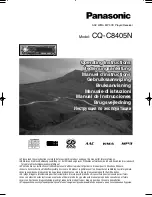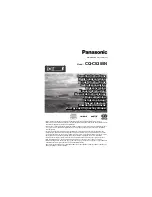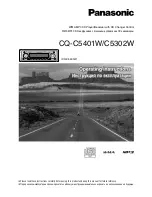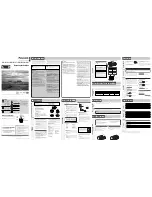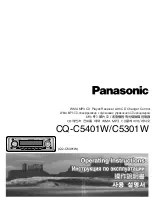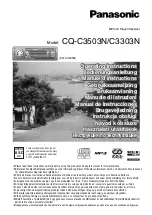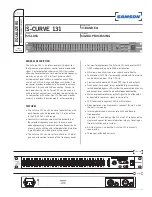
CAUTION: TO REDUCE THE RISK OF ELECTRIC SHOCK,
DO NOT REMOVE COVER.
PROPER VENTILATION REQUIRED.
NO USER-SERVICEABLE PARTS INSIDE.
REFER SERVICING TO QUALIFIED SERVICE PERSONAL.
!
RISK OF ELECTRIC SHOCK
DO NOT OPEN
C A U T I O N
Basic Installation Instructions
The Channel Vision Multi-Room Video CVT Modulator is easy to hook-up.
Just connect your video sources to the CVT Modulator as you would
connect them directly to your TV's "video in."
Determine what channels you want to map your video sources to, then, with
the power off, use the DIP Switch Settings Table to set the dip switches on
the back of the CVT to provide that channel selection range.
Confirm that the video sources you're going to hook up are sending good
signals. Attach them to the video and audio inputs on the back of the CVT
Modulator. Connect the RF output on the CVT Modulator to one input of
the supplied combiner and your existing cable/TV/antenna cable to the
other. Finally, connect the output of the combiner to your TV network and
plug the CVT Modulator in to the wall outlet.
Turn your TV on, then press SELECT on the CVT Modulator to cycle the
front display to the A, B, or C input. Then select the channel you wish to
set (the light on the front panel shows the currently selected input, and the
channel display shows the channel to which that source is currently being
sent). Change the channel by holding the SELECT down for two seconds
until the A/B/C light on the front panel blinks. This puts the CVT
Modulator in channel-change mode.
Press the UP or DOWN buttons on the CVT Modulator to adjust the
channel number as desired. When satisfied, press SELECT again to exit
channel-change mode (the CVT Modulator will automatically exit channel-
change mode after 5 seconds of inactivity). Repeat for your other two input
sources (if applicable). Leave a channel free between your selected
channels to avoid frequency interference. For example, mapping to
channels 32-34-36 is fine, but 32-33-34 is not.
We suggest that you connect a RF distribution amplifier to your cable/
antenna signal (see set up diagram on next page) so you can easily balance
the signal strength of that signal and the CVT Modulator signal. Extreme
Products to be installed by certified dealers only.
Certification Requirements: Must be professional installing dealer, pass
certification test and familiar with TV and antenna systems. Call 800/840-
0288 for Channel Vision Training Manual and certification test.
Note: This equipment has been tested and found to comply
with the limits for a Class B digital device, pursuant to
part 15 of the FCC Rules. These limits are designed to
provide reasonable protection against harmful interference
in a residential installation. This equipment generates,
uses and can radiate radio frequency energy and, if not
installed and used in accordance with the instructions, may
cause harmful interference to radio communications.
However, there is no guarantee that interference will not
occur in a particular installation. If this equipment does
cause harmful interference to radio or television reception,
which can be determined by turning the equipment off and
on, the user is encouraged to try and correct the interfer-
ence by one or more of the following measures:
•
Reorient or relocate the receiving antenna.
•
Increase the separation between the equipment and re-
ceiver.
•
Connect the equipment into an outlet a circuit different
from that to which the receiver is connected
•
Consult the dealer or an experienced radio/TV technician
for help.
CVT1ub/uhf-II, CVT1stereo-II,
CVT2ub/uhf-II, CVT3ub/uhf
FOR HOME OR OFFICE USE
Channel Vision
Tested To Comply
With FCC Stan-
FCC Regulations – the Cable TV Act
“Cable home wiring” is the cable wiring located inside a Cable TV subscriber’s
home or apartment that has been installed by a cable operator or its contractor. It
does not include such items as amplifiers, converters, decoder boxes or remote con-
trol units.
After a subscriber voluntarily terminates cable service, the cable operator may take
one of two action:
1. Leave the home wiring in place.
2. Notify the consumer that it will remove the wiring unless the consumer
purchases it from the cable operator on a per-foot replacement cost basis.
If the wiring was previously transferred or sold to the subscriber, the subscriber owns
it; and the cable company cannot remove it or restrict its use, regardless of the reason
for service termination.
If the subscriber does not already own the wiring and declines to purchase it from the
cable operator, the cable operator may remove the home wiring within 30 days of the
subscriber’s refusal. The cable company must remove the wiring at no charge to the
subscriber, and must pay the cost of any damage caused by removing the wiring.
To leave the wiring inside and remove the wiring outside a subscriber’s home, a
cable operator may, for single unit dwellings, sever the cable approximately 12
inches outside the point where the cable enters the outside wall of the subscriber’s
home.
For multiple unit dwellings, the cable operator may sever the wire approximately 12
inches outside the point where the cable enters the subscriber’s individual dwelling
unit, except in cases of “loop-through” or other similar series wire configurations that
are not covered by the home wiring rules.
If the cable company fails to remove the wiring within 30 days of the subscriber’s
refusal to purchase it, the cable operator forfeits its right to the wiring and may not
remove it or restrict its use at any later time.
A cable operator will not be held responsible for any signal leakage that occurs from
the home wiring once the cable operator ceases providing service over that wiring.












